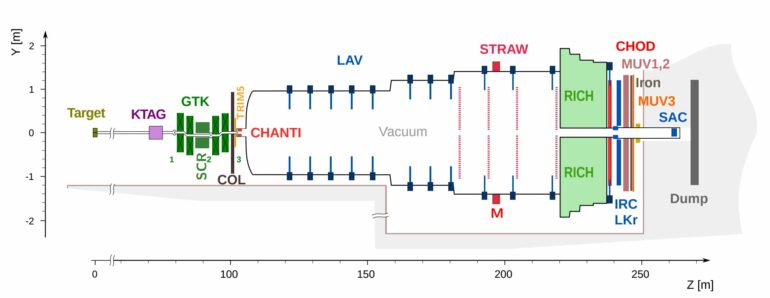Located at CERN’s North Area and receiving beams from the Super Proton Synchrotron (SPS), the NA64 and NA62 experiments search for dark matter, complementing searches at the LHC, as they cover a different energy range. Both experiments have recently published new results. The research is published on the arXiv preprint server.
Dark matter does not seem to interact with our visible world but makes up most of our universe. Researchers assume that the dark sector interacts with the Standard Model via so-called mediators. These mediators could be—for instance—a dark photon, a dark scalar boson and an axion, which could be distinguished by how they interact with Standard Model particles.
The NA62 experiment, which was designed to study the ultra-rare kaon decay into a charged pion and two neutrinos, has now searched for possible contributions from dark-matter particles to another rare kaon decay. The researchers used a beam consisting mainly of pions and kaons, produced by firing the 400 GeV/c SPS proton beam onto a beryllium target.
The rare kaon decay into a pion and a pair of photons, subsequently decaying into two electron-positron pairs, is particularly interesting, as hypothetically, dark bosons would decay into the same final states as Standard Model photons.
Although the experimentalists did not find evidence for such a rare decay, nor for a dark boson, they placed the most stringent upper limits to date by analyzing data recorded in 2017 and 2018. In addition, the experimentalists excluded the axion as a possible explanation for the 17 MeV/c2 ATOMKI anomaly and thus confirmed previous findings by the NA64 experiment.
The NA64 collaboration hunts for invisible light dark-matter particles that interact with Standard Model particles through a possible dark photon. Using electron collision data collected between 2016 and 2022, corresponding to 9.4 × 1011 electrons on target, NA64 started to probe the very exciting region of parameter space predicted by two benchmark dark-matter models for the first time.
Their data set excludes leading sub-GeV dark-matter candidates with a coupling between the dark-matter particle and the dark photon for a range of dark-matter particle masses, ruling out both models. To obtain these results, the NA64 experiment used a 100 GeV/c electron beam generated from protons interacting with a fixed target. The collaboration utilized an active beam dump and attempted to reconstruct the hypothetical dark photon, via both visible electron-positron pairs and missing energy for invisible decays.
More information:
NA62 collaboration, Search for K+ decays into the π+e+e–e+e– final state, arXiv (2023). DOI: 10.48550/arxiv.2307.04579
Citation:
Researchers publish new results from dark boson searches (2023, August 21)



